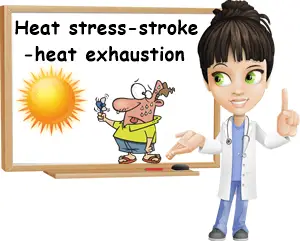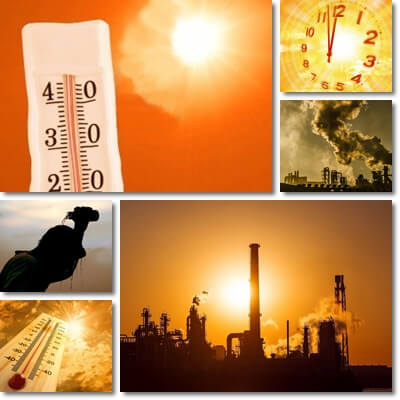What is the difference between heat stress, heat exhaustion and heatstroke? The main difference between the three is that they represent various stages of heat-related illness and produce symptoms of varying severity. In escalating order: heat stress, heat exhaustion, heatstroke. Heat stress typically elicits milder physiological reactions. Heat exhaustion has more pronounced symptoms and may require medical attention if allowed to progress. Heatstroke is severe and requires immediate medical attention.
What is heat stress?
Heat stress is a very general notion denominating thermal stress from overheating. It may refer to varying degrees of thermal stress, depending on the intensity of the physiological response it elicits. For example, heat stress can designate mild overheating as a result of prolonged exposure to high temperatures. It is also considered an early stage of heat exhaustion, a more serious form of health-related illness. At the same time, it may be used to refer to an entire range of heat-related illnesses, from mild thermal discomfort to more serious heat exhaustion leading to heatstroke.

Symptoms of heat stress may include mild to moderate physiological discomfort from overheating, with hot skin sensation and profuse sweating, possibly also a heat rash caused by the sweating. If exposure to high temperatures is prolonged, dehydration can easily occur from the sweating and lead to further side effects, including heat cramps, a typical symptom. Cardiovascular symptoms such as arrhythmia, fast heartbeat, altered breathing pattern may occur.
What is heat exhaustion?
Heat exhaustion is a result of prolonged heat stress. It is often regarded as a second degree-kind of heat stress. Symptoms include muscle weakness, fatigue, headaches, dizziness, nausea and even vomiting and fainting. If left untreated, it can lead to loss of consciousness or escalate into heatstroke. It is actually caused by dehydration brought on by excessive sweating as a result of prolonged exposure to high temperatures. Both loss of fluids/water and loss of electrolytes (the minerals sodium, potassium, magnesium, calcium) are responsible for the symptoms.
What is heatstroke?
In simpler words, it is extreme overheating caused by exposure to high temperatures, usually hot sunlight. Of the three, it is the most dangerous form of heat-related illness and can easily lead to disability or worse if left untreated. Symptoms of heatstroke include abnormally high body temperature, dry, hot skin, flushing, cardiovascular symptoms such as increased heart rate, altered mental state, convulsions and ultimately loss of consciousness. Learn more about Heatstroke: Causes, Symptoms and Treatment.

1) Heat stress is the same thing as heat strain and both refer to the usually mild physiological strain caused by increased core body temperature. Basically, prolonged exposure to high temperatures and/or the lack of means to cool down (ex: ventilation, air conditioning, access to water, ice packs) cause the body to exhaust its thermoregulating resources and overheat. See Heat Stress: Causes, Symptoms and Treatment.
2) Heat exhaustion is heat stress allowed to continue for too long, which is until the body exhausts its thermoregulating resources. For example, excess exposure to high temperatures triggers sweating as a means to cool down the body. But sweating also causes dehydration through loss of water and electrolytes which affects both blood volume and heart activity (electrolytes such as potassium, sodium, magnesium regulate heart activity).
So, in the case of heat exhaustion, it’s water and electrolytes/salts that are exhausted through sweating (mostly) and this is what causes the specific symptoms. For example, low fluid levels in the body can cause thirst, dry mouth and throat, generalized muscle weakness, fatigue, lightheadedness, dizziness, headaches and even fainting (not as in heatstroke, though). Low electrolytes levels in the blood causes an electrolyte imbalance which can lead to symptoms such as muscle spasms, muscle cramps in calves, thighs, feet, arms, legs, abdomen or chest, eyelids, even nausea, vomiting sensation, irritability, lethargy and irregular heartbeat.
3) Heatstroke can occur gradually (build up from heat stress slowly). Or it can occur without prior notice (in other words, a person may not experience heat stress or heat exhaustion symptoms ahead of it). It is caused by too high a body temperature which can lead to brain damage or damage to other organs, disability or worse. It is the most severe form and requires immediate medical attention.
Examples of situations that could lead to heat stress and its more severe forms: sitting in the hot sun for too long, sweating excessively and not replenishing lost water and electrolytes, working in a factory without ventilation, driving in a car without air conditioning in hot weather, wearing protective equipment which prevents heat loss through the evaporation of sweat, living or working in high humidity (doesn’t allow for sweat to evaporate), spending too much time in proximity to heat sources (radiators, boilers, ovens, stoves, furnaces) etc.
All three forms of heat illness are best addressed in their earliest stages and not allowed to progress. Learn what symptoms to look out for and how to combat them. Here is some useful advice:
1) Limit exposure to high temperatures or remove yourself from such an environment as soon as you start to feel unwell.
2) Stay hydrated and know that hydration means replenishing both fluids (water) and electrolytes (salts). Still water, natural mineral water (which has potassium, magnesium, sodium, calcium naturally), oral rehydration solutions or sports drinks (with electrolytes and vitamins) are good options. Use them whenever you are feeling weak or experience arrhythmia, palpitations, extrasystoles, low blood pressure, fainting sensation.
3) Know that you can combat heat cramps with magnesium and fluids.
4) Prevent fainting with water and electrolytes.
5) Check urine color to see if you are well hydrated. Light yellow is a color that indicates an optimal levels of hydration. Find out more about other Urine Colors Meanings.
6) Eat light, wear light clothing from breathable fabrics like cotton, sunscreen and a hat when it’s hot outside and stay out of direct sunshine.
7) Avoid outdoor activities between 11 a.m. and 3-4 p.m. if temperatures are high.
8) Avoid driving in hot weather if you don’t have air conditioning.
9) Use moist, damp towels or ice packs covered in a towel to cool down. Apply on wrists, hands, ankles, feet, under armpits.
10) Do not use ice directly on skin and avoid cold showers – it can cause a cold water shock. See Cold Shock: Causes, Symptoms and Treatment. Instead, put ice in a towel or take a lukewarm or tepid shower (the water evaporating from the skin is what helps cool down the body).
11) Seek medical help if you experience irregular heartbeat, vomiting, dizziness, fainting sensation, altered mental state or any symptom that you feel is not right.
